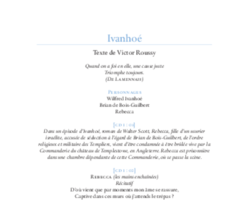Ivanhoé
Cantata for the Prix de Rome for composition, composed en loge in June 1864.
Twelve years after graduating from the Paris Conservatoire and an unsuccessful first attempt at the Prix de Rome (with the cantata Le Retour de Virginie), Camille Saint-Saëns — to everyone’s surprise — tried once again to obtain a ticket for the Villa Medici. This was the last competition he could enter: the following year he would exceed the age limit of thirty set for candidates. The young composer was then well known in Paris, and his œuvre, with some thirty works, already covered most fields except opera. Was it precisely to assert his operatic ambitions that he entered his examination loge in June 1864? Or was it simply to obtain an award that he knew would open the doors to an official career? In any case, when the cantatas were judged, Saint-Saëns was left out of a list of winners in which only Victor Sieg’s name appeared. Inspired by Walter Scott, Ivanhoé nevertheless offered the unsuccessful candidate the opportunity to fully display his style. As Yves Gérard points out, it contains “all the characteristics of what would become Saint-Saëns’s ‘system’ of dramatic writing, if only in Samson et Dalila, whose Act II he would compose from 1867 onwards: recurring motifs filling in a dense, contrasting symphonic framework, sinuous arabesques alongside clear melodic themes, and varied colours in the handling of instrumental timbres”. The academic disavowal was soothed by Saint-Saëns’s victory in the competition for the 1867 International Exposition with Les Noces de Prométhée.

